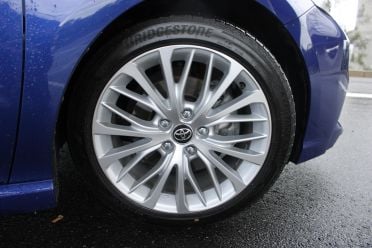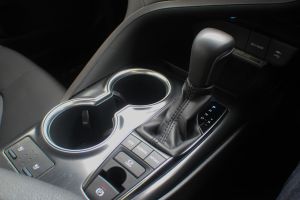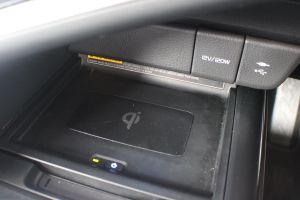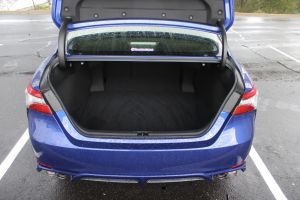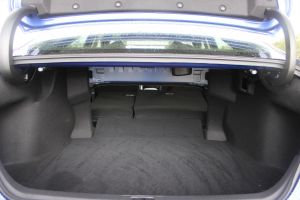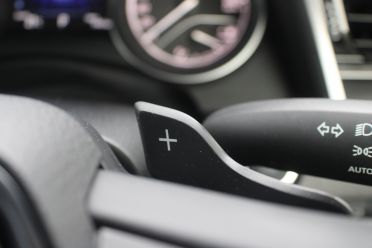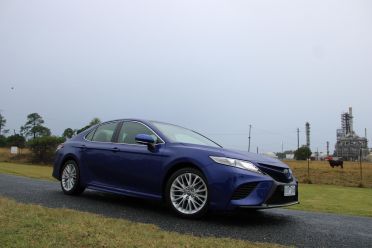The mid-sized sedan segment may be declining but the Toyota Camry retains a stranglehold on it.
Last year, it held just over 64 per cent market share. If you lump in the cars VFACTS illogically classifies as Large – like the similarly-sized Holden Commodore – the Camry still has almost 50 per cent market share.
The latest Toyota Camry, introduced in 2018, benefited from a move to Toyota’s TNGA platform, casting aside the K platform that had been used and continuously updated since 2001.
Toyota’s taken the opportunity to thoroughly overhaul the Camry’s looks. You’ll find the shape of the headlights and taillights are similar to the last car but this is no mere evolution. It now measures 1445mm tall, a reduction in height of 25mm. That gives it a more svelte appearance, while the beltline also appears lower.
Most importantly, the latest Camry looks like it was designed first as a sporty SX or luxurious SL. Past high-spec Camrys have looked like regular Camrys with stuff stuck on – like the old Sportivos – or haven’t looked much different from lower-spec models.
With the latest Camry, however, there’s clear differentiation in higher grades from the base Ascent. That includes a completely different and more aggressive grille and front bumper, with gloss-black mesh inserts and a prominent body-colour dividing line.
SX and SL Camry tail lights also have little aerodynamic details that curve out and down, which echo the shape of the Lexus LC coupe’s tail lights. Both models also feature attractive wheel designs – 19-inches for the SX and 18-inches for the SL here.
The Camry’s exterior won’t completely alienate loyal customers – you can even still get it in a beige-y colour – but it goes a long way towards appealing to people who mightn’t have considered a Camry before. Does a Lexus ES look $18,000 nicer?

How much does the Toyota Camry SL V6 cost?
The Camry SL V6 costs $43,990 before on-road costs, exactly $3000 more than the SL Hybrid and $4000 more than the regular SL four-cylinder.
The only option is metallic paint, which costs $500. That includes the Lunar Blue of our tester.
What do you get?
The SL V6 is equipped identically to the other Camry SLs, with one key distinction: the single-pane sunroof found on the SL Hybrid is swapped out for a panoramic sunroof.
Standard equipment includes an 8.0-inch touchscreen infotainment system with Android Auto, Apple CarPlay and satellite navigation, as well as leather upholstery, Qi wireless phone charging, a power tilt-and-telescoping steering wheel, rain-sensing wipers, proximity entry with push-button start, and eight-way power front seats.
These features are in addition to adaptive cruise control and adaptive high beam, which are standard across the Camry range.
There are some curious omissions, however. The front seats are ventilated but not heated – usually it’s the other way around – while there’s no surround-view camera or power-folding mirrors.
Heated front seats are available in other markets though we imagine if most Aussies had to choose between the two, ventilated seats would be more desirable due to our climate.
Is the Toyota Camry safe?
When ANCAP tested the Camry in 2017, it awarded it a score of five stars. That was based on a frontal offset score of 15.16 out of 16 points, and whiplash and pedestrian protection scores of Good and Acceptable, respectively.
Autonomous emergency braking with forward-collision warning is standard on all 2020 Camrys. The system works at speeds between 10 and 180km/h, though it can only detect pedestrians at speeds between 10 and 80km/h.
Other standard safety kit includes blind-spot monitoring, rear cross-traffic alert, lane-departure warning, lane-keeping assist, and front, front-side and curtain airbags, plus a driver’s knee airbag.
What is the Toyota Camry SL V6 like on the inside?
This isn’t just a stylish interior for a Camry, it’s a stylish interior, period. It’s also the most impressive Camry interior since the excellent 1993 model.
It’s an enormous improvement over the dour interior of the last Camry, with its abundance of hard plastic and tacky faux stitching. In the current car, there’s lovely, soft-touch plastic to be found on the dash top and at the tops of all the doors. Leatherette extends from the passenger’s side of the dash to the side of the centre console and is also used on the door trims.
Though the interior is black with a gloss black centre stack, Toyota’s employed subtle dark brown accents on the seats with matching brown stitching details on the dash.
The only visual misfire in the interior is the brown trim on the dash. It appears to be following in the proud Toyota tradition of egregiously fake wood trim, to the point where we’re not even sure it’s supposed to be wood. Fortunately, it’s balanced out with some subtle, classy blue accent lighting.
There’s a striking, asymmetric look to the dashboard but the Camry hasn’t sacrificed function for form. The 8.0-inch touchscreen infotainment system is neatly integrated into the centre stack and all the switchgear falls easily to hand, with nothing buried inconveniently low. Tucked away below the controls is a Qi wireless charging pad.
Toyota’s finally abandoning its venerable cruise control stalk, in favour of a much more attractive set of buttons on the steering wheel. They’re laid out similarly to many rivals’ controls.
A head-up display is new to the Camry line. It’s a severely underrated safety feature, and helps keep your eyes on the road as much as possible. Unlike some cars, it also displays the gear you’ve selected.
The 7.0-inch instrument cluster display and 8.0-inch touchscreen are informative and easy to navigate, though their displays lack visual panache.
If hospitals had satellite navigation systems, we imagine they’d look like the Camry’s. The graphics are a bit Refidex in appearance and, from a functional standpoint, it’s letdown by the absence of streets.
We found whole roads, in existence for several years, missing from the system. The system also froze on one occasion, while – like many factory navigation systems – you can’t simply use voice commands to say, “Take me to [suburb].”
Google Maps allows you to navigate to a suburb without having a specific address, and it’s about time factory set-ups let you do the same.
The touchscreen and the gauge cluster display are further let down by their gloomy blue screens. While the blue backlighting of the switchgear and the matching ambient lighting is classy, the screens’ use of blue is blah.
The seats are superbly plush and comfortable, as befitting a top-spec Camry. The seat ventilation is a bit noisy, which is an issue we’ve encountered on other Toyota and Lexus models. Unlike some other cars, however, the ventilated seats will turn themselves back on when you restart the car.
Despite the panoramic sunroof, there’s also sufficient headroom both front and rear, at least for somebody measuring around 180cm tall. Compared with the Corolla, the rear seat of the Camry is positively palatial.
There’s ample legroom, while occupants also have two USB outlets, bottle holders in the doors that fit 600ml bottles, pockets in the soft seat backs, and rear vents that look like they’ve been in Toyota’s parts bin since the 1990s.
The Camry interior isn’t perfect. The interior door handles feel cheap, the shifter isn’t the nicest in the segment, the rain-sensing wipers can be a little slow on the uptake, and we observed the faintest of rattles from the panoramic sunroof, proving even Toyota isn’t immune to such a common issue. But overall, this is an exceptionally attractive and pleasant cabin.
The boot is just as big as ever, too. Cargo volume is 524L, while underneath the floor is a space-saver tyre. The rear seats fold 60:40, though the opening to the boot is a bit smaller than expected.
What’s under the bonnet?
For the current XV70 generation, the Toyota Camry received the 2GR-FKS direct-injected, naturally-aspirated 3.5-litre V6 engine first introduced in Lexus models in 2015. It uses both the Atkinson and Otto cycles and is more powerful than the previous 3.5-litre while also seeing a slight improvement in fuel economy. The sole transmission is an eight-speed torque-converter automatic.
The only downside is it now requires a diet of 95RON premium unleaded fuel.
Outputs are frankly silly for a Camry: 225kW of power and 362Nm of torque. With its 2002 Altima, Nissan sparked the horsepower wars in the US mid-size segment where the Camry reigns supreme, culminating with this Camry’s engine and its output of 301hp. It’s come just as almost every rival has switched to turbocharged four-cylinder engines (e.g. the Honda Accord) or left production (Holden Commodore).
How does the Toyota Camry SL V6 drive?
In a word: serenely.
The Camry manages its heady 225kW output like a stately home’s majordomo who’s well-versed in the art of discretion. The master and lady of the house needn’t be concerned with such matters as wheel spin, so the Camry’s traction control deftly and unobtrusively keeps the front wheels in check as the car accelerates.
What could be a torque-steering mess, therefore, becomes entirely pleasant to drive with a linear power delivery. Indeed, power builds progressively with the revs instead of overwhelming the front wheels at the slightest application of throttle. It certainly doesn’t feel slow, but it also doesn’t feel quite as fast as its outputs would suggest.
You might say the fun has been sucked out of such a high-output V6, but just how much were you planning to tear up the streets in a large, front-heavy, front-wheel drive sedan?
It handles well for such a vehicle, though you’ll notice some body roll in corners. If that’s of concern, the SX and its sport-tuned suspension might be more your speed.
Then again, this is still a car with a lot of its weight up front. The SL V6’s kerb weight is 70kg higher than the regular four-cylinder model and only 5kg lighter than the SL Hybrid, which features better weight distribution due to the placement of its hybrid hardware under the rear seat.
The steering is surprisingly heavy, which helps make the car feel more engaging. Switching to sport mode makes no particularly tangible difference in how the car drives. Regardless of drive mode, you can manually shift using the paddle shifters but, even in sport mode, you’re countermanded almost instantly.
Best to just leave the smooth-shifting eight-speed automatic to its own devices, as it’s quite a well-calibrated unit.
Overall, ride quality is quite good. Only the harshest of bumps will reverberate through the structure, the Toyota Camry dispatching most everything with ease. The cabin is serenely quiet at all but highway speeds, with a little tyre roar and wind noise around the mirrors creeping into the cabin.
Toyota’s lane-keeping assist remains disappointing. The lane-departure warning is quick to alert you if you cross into another lane but the “steering assist” function, as Toyota calls it, is useless. Rather than perceptibly intervening, the lane-keeping assist must’ve been drafting a strongly-worded letter to the power steering unit.
We averaged 11.6L/100km over a mix of city and highway driving, quite a bit higher than the claimed 8.9L/100km on the ADR combined cycle. As mentioned earlier, the Camry also now requires 95RON premium unleaded.
How much does the Toyota Camry SL V6 cost to run?
In addition to its five-year, unlimited kilometre warranty, Toyota offers five years of capped-price servicing. Each service costs $200; the Camry requires servicing every 12 months or 15,000km.
CarExpert’s take on the Toyota Camry SL V6
The Toyota Camry SL V6 impresses with its refinement and its stylish good looks, both inside and out.
If you want a large V6 sedan for under $50,000, your only other option is the Subaru Liberty 3.6R. Even it is switching to a turbo four-cylinder engine for its upcoming, seventh generation, while the current car – all-wheel drive aside – doesn’t really offer much over the Camry.
Perhaps the sharpest competition the SL V6 faces is from within its own range. The SL Hybrid costs $3000 less while offering fuel efficiency almost twice as good, although its sunroof is half the size.
The SL V6 might have a powerful V6 engine but it’s no sports sedan, so we reckon the SL hybrid is your best bet.







